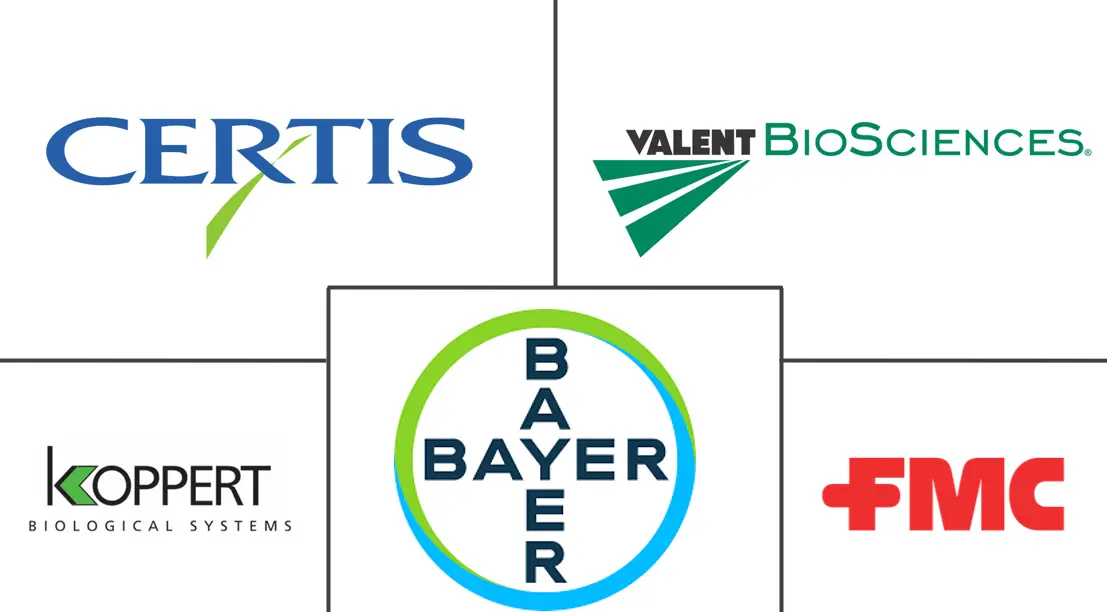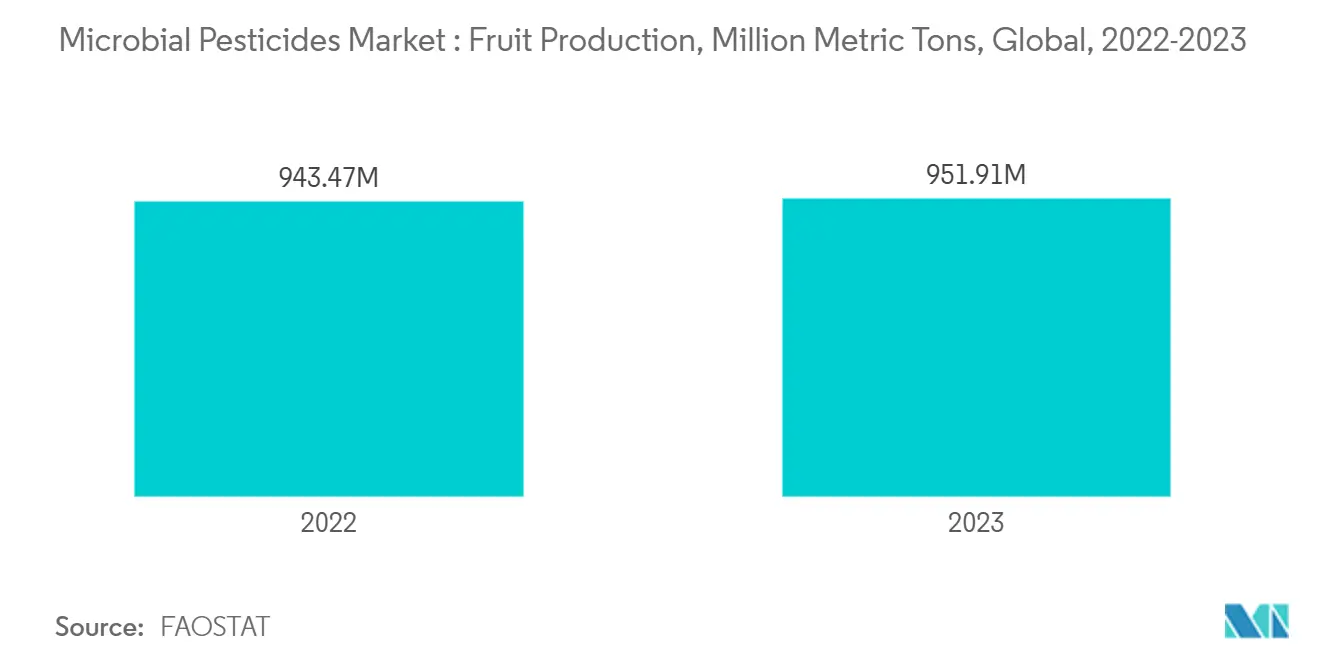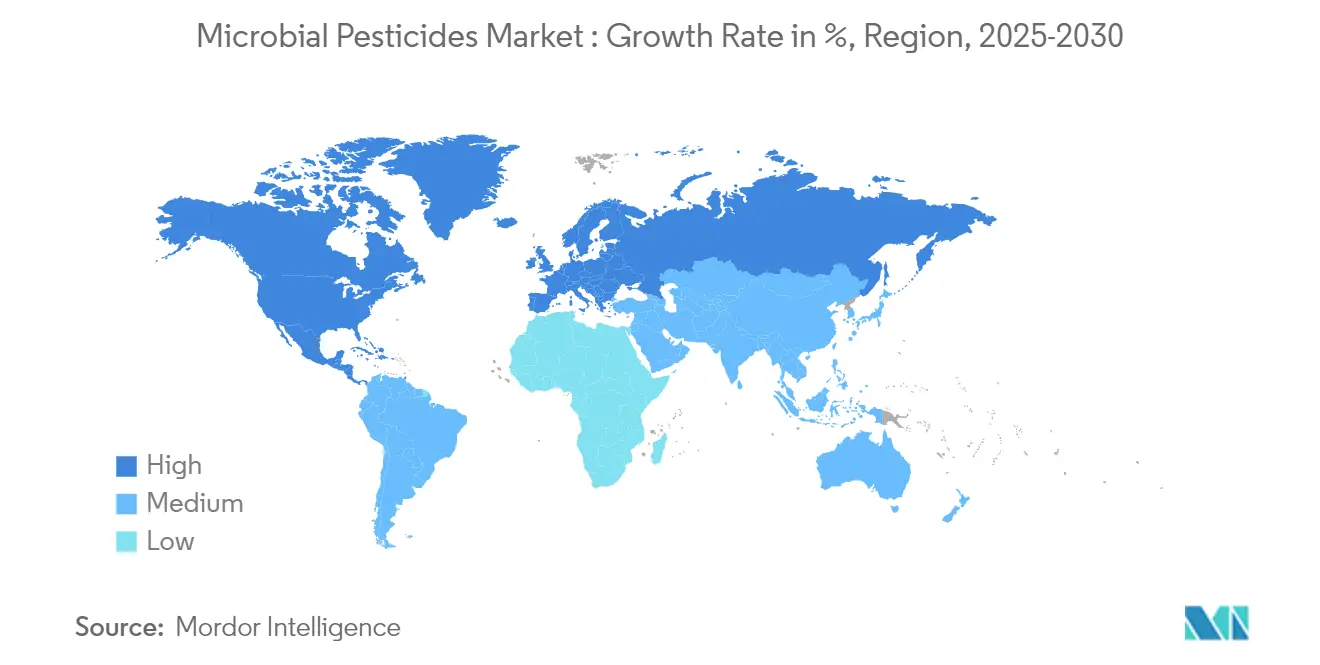Microbial Pesticides Market Analysis
The Microbial Pesticides Market size is estimated at USD 1.45 billion in 2025, and is expected to reach USD 1.98 billion by 2030, at a CAGR of 6.42% during the forecast period (2025-2030).
The continued use of chemical and synthetic pesticides in agriculture has raised concerns about their effects on human health, animal welfare, and environmental safety, leading to increased adoption of microbial pesticides. Several countries have implemented stricter regulations on pesticide imports, particularly regarding residue levels. The focus on food safety and quality has made microbial pesticides a more suitable alternative to synthetic options.
The incorporation of microbial pesticides into Integrated Pest Management (IPM) programs reduces dependency on synthetic pesticides while maintaining crop yields. According to the Food and Agriculture Organization (FAO), global agricultural land in 2022 covered 4,781 million hectares, representing more than one-third of Earth's land area. This included 1,573 million hectares of cropland and 3,208 million hectares of permanent meadows and pastures, reflecting increased crop production demands and pest management needs.
The decline in arable land has made technological advancements essential for increasing agricultural productivity. Consumers across countries are demanding high-quality organic food at affordable prices, driven by increasing incomes and greater awareness. According to the Organic Trade Association (OTA), organic sales in the United States reached USD 69.7 billion in 2023, up from USD 67.6 billion in the previous year. The market shows increasing preference for farming methods that preserve natural resources, reduce environmental impact, and support rural sustainability and animal welfare. Governments are encouraging the implementation of new farming technologies to support sustainable agricultural practices.
Microbial Pesticides Market Trends
Fruits And Vegetables Segment Holds a Significant Position in The Market
Fruits and vegetables constitute a major segment of the microbial pesticide market due to the increasing demand for organic and sustainable farming practices. Microbial pesticides are natural, environmentally friendly alternatives to chemical pesticides, and their use is growing in response to both regulatory pressures and consumer preferences for safer food products. The global increase in fruit and vegetable production drives bio-insecticide demand. According to FAOSTAT, global fruit production increased from 943.47 million metric tons in 2022 to 951.91 million metric tons in 2023. The growth in the global population and the shift toward organic, pesticide-free food have made bio-insecticides essential for pest management in fruit and vegetable cultivation.
The increasing demand for organic fruits and vegetables has made microbial pesticides a preferred choice for farmers pursuing organic certification. These pesticides are biodegradable and create minimal environmental impact compared to chemical alternatives, supporting sustainable agricultural practices. Bacillus thuringiensis (Bt), a widely used microbial pesticide, protects fruits and vegetables from caterpillars and moth larvae. The proteins produced by Bt are lethal to specific insect larvae while remaining safe for humans, animals, and beneficial insects. Common applications include crops such as tomatoes, potatoes, and leafy greens.
Climate change has resulted in unpredictable weather patterns and increased pest resistance to conventional chemical pesticides. Microbial pesticides provide targeted pest control and reduce the likelihood of pesticide resistance compared to traditional chemicals, making them effective for addressing emerging pest challenges. Fall armyworms have become significant pests in Africa, damaging maize, tomatoes, and beans. Their resistance to chemical insecticides has increased the adoption of bio-insecticides, such as Bt, which provides effective control in affected regions.
North America Dominates the Market
The increasing understanding of chemical herbicides and pesticide impacts has driven a transition toward bioherbicides in integrated weed management. Bioherbicides, functioning as biological weed control agents, are produced from phytotoxins, pathogens, and microbes. Bioherbicides are derived from microbial compounds and secondary metabolites, including fungi, bacteria, and protozoa, as well as phytotoxic plant residues, extracts, and specific compounds from various plant species. Regional demand has increased due to growing interest in environmentally sustainable agricultural practices and the elimination of conventional products facing re-registration difficulties and efficacy issues.
Product development has driven microbial pesticide demand, with modern biological active ingredients and products that effectively complement and compete with conventional chemical pesticides. The microbial biopesticide market has expanded due to an increased focus on sustainable food production, farmer concerns about chemical dependence and rising chemical crop protection costs. This trend is particularly evident in the U.S. biological sector, creating significant opportunities for microbial pesticide adoption.
In 2023, the United States Environmental Protection Agency (EPA) approved a new biopesticide containing Ledprona as its active ingredient. Ledprona, a sprayable double-stranded ribonucleic acid (dsRNA), targets the Colorado potato beetle, a major pest affecting U.S. potato crops. The EPA's approval of new microbial ingredients demonstrates the continued growth in the microbial pesticide market.
Microbial Pesticides Industry Overview
The market for microbial pesticides is extremely fragmented, with a large number of firms controlling the majority of the market share, along with several small companies and private labels. Bayer, FMC Corporation, Koppert Biological Systems, Valent Biosciences Corporation, and Certis USA LLC are some of the prominent companies in the market studied. Leading companies in the market primarily adopt strategies such as new product launches, partnerships, and acquisitions. In addition to these, innovations, expansions, and investments in R&D, along with the development of novel product portfolios, are expected to play pivotal roles in the coming years. Notably, significant acquisitions among companies to advance microbial pesticides underscore a swift pivot toward bio-based products. Market players are making substantial investments to broaden their biological research divisions, capitalizing on the marketplace's expansion.
Microbial Pesticides Market Leaders
-
Valent Biosciences Corporation
-
Koppert Biological Systems
-
Certis USA LLC
-
FMC Corporation
-
Bayer
- *Disclaimer: Major Players sorted in no particular order
Microbial Pesticides Market News
- January 2024: Certis Biologicals has launched 'Convergence', a biofungicide that excels in both disease management and bolstering plant vitality, all while being budget-friendly. Targeting a range of threats, it effectively combats soilborne and foliar diseases from pathogens like Pythium, Rhizoctonia, Fusarium, and Phytophthora.
- August 2023: FMC India has launched ENTAZIA biofungicide, an innovative product in biological crop protection crafted with Bacillus subtilis. This state-of-the-art solution equips farmers with a robust and eco-friendly means to shield their crops from fungal threats.
Microbial Pesticides Industry Segmentation
Microbial pesticides, a subset of biopesticides, utilize naturally occurring agents like bacteria, viruses, fungi, or protozoans to address specific issues. These agents harness nature's inherent mechanisms for biological pest control, safeguarding plants from pests and diseases without resorting to chemicals. The Microbial Pesticides Market is Segmented by Ingredient Type (Bacteria-Based Pesticides, Fungi-Based Pesticides, Virus-Based Pesticides, and Other Ingredient Types), Product Type (Microbial Fungicide, Microbial Insecticide, and Other Product Types), Application (Grains & Cereals, Pulses & Oilseeds, Fruits & Vegetables, and Other Applications), and Geography (North America, Europe, Asia-Pacific, South America, and Africa). The Market Size and Forecasts are Provided in Terms of Value (USD) for all the Above Segments.
| Ingredient Type | Bacteria-based Pesticides | ||
| Fungi-based Pesticides | |||
| Virus-based Pesticides | |||
| Other Ingredient Types | |||
| Product Type | Microbial Fungicide | ||
| Microbial Insecticide | |||
| Other Product Types | |||
| Application | Grains & Cereals | ||
| Pulses & Oilseeds | |||
| Fruits & Vegetables | |||
| Other Applications | |||
| Geography | North America | United States | |
| Canada | |||
| Mexico | |||
| Rest of North America | |||
| Europe | Spain | ||
| United Kingdom | |||
| France | |||
| Germany | |||
| Russia | |||
| Italy | |||
| Rest of Europe | |||
| Asia Pacific | China | ||
| India | |||
| Japan | |||
| Australia | |||
| Rest of Asia Pacific | |||
| South America | Brazil | ||
| Argentina | |||
| Rest of South America | |||
| Africa | South Africa | ||
| Rest of Africa | |||
Microbial Pesticides Market Research Faqs
How big is the Microbial Pesticides Market?
The Microbial Pesticides Market size is expected to reach USD 1.45 billion in 2025 and grow at a CAGR of 6.42% to reach USD 1.98 billion by 2030.
What is the current Microbial Pesticides Market size?
In 2025, the Microbial Pesticides Market size is expected to reach USD 1.45 billion.
Who are the key players in Microbial Pesticides Market?
Valent Biosciences Corporation, Koppert Biological Systems, Certis USA LLC, FMC Corporation and Bayer are the major companies operating in the Microbial Pesticides Market.
Which is the fastest growing region in Microbial Pesticides Market?
South America is estimated to grow at the highest CAGR over the forecast period (2025-2030).
Which region has the biggest share in Microbial Pesticides Market?
In 2025, the North America accounts for the largest market share in Microbial Pesticides Market.
What years does this Microbial Pesticides Market cover, and what was the market size in 2024?
In 2024, the Microbial Pesticides Market size was estimated at USD 1.36 billion. The report covers the Microbial Pesticides Market historical market size for years: 2019, 2020, 2021, 2022, 2023 and 2024. The report also forecasts the Microbial Pesticides Market size for years: 2025, 2026, 2027, 2028, 2029 and 2030.
Our Best Selling Reports
Microbial Pesticides Industry Report
Statistics for the 2025 Microbial Pesticides market share, size and revenue growth rate, created by Mordor Intelligence™ Industry Reports. Microbial Pesticides analysis includes a market forecast outlook for 2025 to 2030 and historical overview. Get a sample of this industry analysis as a free report PDF download.







